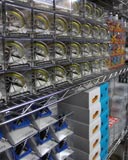The Yoshimoto Cube is a polyhedral mechanical puzzle toy invented in 1971 by
Japanese man Naoki Yoshimoto. The cube is made up of eight interconnected cubes
and it is capable of folding and unfolding itself in a cyclic fashion. You can keep folding,
or unfolding the cube, indefinitely. Once folded, the cube can be turned into two
rhombic stellated dodecahedrons. Yoshimoto discovered that these two shapes could
pieced together into a square when he was finding different ways he could split a
cube equally in half.
As a work that delves into the aesthetics of math and geometry,
it was selected in 1982 by the Museum of Modern Art in New York for
inclusion in its permanent collection. It makes a great toy for children, or a
desktop object.


☰ Menu



-1200.webp)
-180.webp)
-180.webp)
-180.webp)


